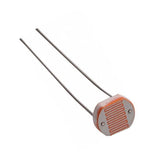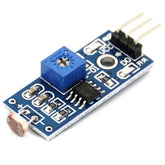Light dependent resistor: Complete Guide
Summary
Explore the fascinating world of Light Dependent Resistors (LDRs) with our comprehensive guide! Uncover the basics in our Introduction to LDR, discover the inner workings of these remarkable sensors, and delve into the various types available. Learn how LDRs are employed in diverse applications, from security systems to ambient light controls. Our guide not only unveils the practical uses of LDRs but also sheds light on their applications in the ever-evolving tech landscape. Ready to illuminate your knowledge? Dive into our enlightening exploration of Light Dependent Resistors and brighten up your understanding of this essential electronic component!
Introduction to light dependent resistor
Light dependent resistor (LDR), also known as a photoresistor, is an electronic component that has a wide variety of applications in light sensing technology. It functions by changing its electrical resistance when exposed to changes in ambient light intensity or wavelength; this enables it to measure and detect these variations accurately.
LDRs are commonly used for lighting control systems such as dimmer switches, motion detection sensors and security camera systems due their ability to rapidly respond even during small voltage fluctuations or sudden changes in the environment's illumination level.

Other use cases include providing feedback loops for solar panels' performance monitoring and helping calibrate RGB LED displays so they can achieve optimized colour accuracy on all brightness levels which helps reduce power consumption while still maintaining vibrant picture quality output standards.
No matter what your application may be, having reliable optical sensor solutions with adjustable sensitivity settings is essential if you want high precision measurements between 0-100% illuminance range without any hassle or costly maintenance down the road – something most Light Dependent resistors will guarantee at competitive price points nowadays thanks advances made over last decade alone!
read our blog explaining the uses of ldr, the working principle of LDR, Variations in resistance to change in light intensity, types, advantages, disadvantages, and applications of LDR sensors.
Explore the principle of operation behind Light Dependent Resistors.
What is a light dependent resistor
A Light Dependent Resistor (LDR) is a device that varies its electrical resistance, depending on the amount of light it receives. It has two terminals connected to a semiconductor material such as silicon or germanium.
When no light shines onto the LDR, effectively sealing off one end of each terminal from exposing any electrons and thus creating an insulating medium between them, thereby reducing current flow through this path resulting in high resistor values.
Conversely when exposed to intense levels of illumination both ends are open for electron flow driving down total resistances between these points while enabling lower operating currents along those route paths accordingly. In essence LDR’s adjusts electricity conduction based on variations in incident intensities via exterior ambient sources meaning their potential applications span far beyond basic switching circuits and simple digital devices into wider arenas like photovoltaic cells , night vision systems , infrared detection gadgets etc; making them essential components within numerous industries across multiple domains today everywhere!
Light dependent resistor working
Light dependent resistors (LDRs) are a form of sensor technology often used in smart systems and home automation. LDRs measure the level of light in an environment by varying their resistance according to changes in ambient lighting levels.
This makes them useful for applications such as dimming lights or detecting presence, allowing automated circuits respond more accurately within set parameters, improving accuracy and results compared with older style traditional sensors that may not be sensitive enough when faced with environmental variables like changing sunlight conditions.

Furthermore, because these devices come already calibrated they require no additional tuning which can drastically reduce costs associated with installation and maintenance depending on the application they’re being used for - making them attractive from both performance-related running cost savings but also initial set up investments compared to manual systems requiring far higher labour input over setup period timeframes.
Read our blog explaining how LDR works, detailing what is an LDR, how LDR Works in Street Lights, what are the types of LDR, how to make an LDR Sensor Module and applications of an LDR Sensor.
Types of light dependent resistor
Light dependent resistors (LDRs) are important components in a wide range of circuits, from simple toys to sophisticated electronic systems. There are two basic types of light dependent resistor: photoconductive and photoresistive.
Photoconductive LDRs rely on the electrical properties of semiconductor materials such as gallium arsenide or silicon. When illuminated by light, they increase their conductivity, allowing current to flow more easily through them than when they are not lit up which results in lower resistance values under bright conditions compared with dark ones.
They usually have short response times but can be quite sensitive depending on the design details involved. Photoresistive LDRs also depend upon illumination for their operation, as well as varying temperatures due to changes in ambient brightness - this makes them ideal for temperature compensation applications where exact accuracy is required over extended periods of time even if environmental lighting levels change considerably!
These devices make use of thin layers carbon material deposited onto ceramic substrates that swell or shrink based both heat and exposure to different wavelengths; thus causing an associated decrease or increase respectively according respective resistance value accordingly – necessitating input calibration – often automated via measurement inputs capacitors etc.
All things considered however these amazing little inventions provide immense flexibility combined with extreme robustness owing largely to remarkable processing parameters meaning that regardless application requirements it shouldn’t prove too difficult finding suitable appropriate product solution existing inventory!
If you want to know about ldr sensor and how they work then read our blog on How LDR Sensor Works
Light dependent resistor uses
Light dependent resistors, or LDRs as they are commonly known, have been widely used in the industrial and commercial world for decades. They offer a unique way to control electrical devices automatically based on the amount of ambient light present in their environment.
These types of sensors can be found everywhere from automated switching systems that turn lights off and on at certain times throughout the day to medical equipment such as glucose monitors that detect levels of light entering an area before making adjustments accordingly.
Furthermore, these reliable components are utilized within agriculture systems where soil moisture content is measured by accurately sensing changes in reflected sunlight across a field's surface. Allowing businesses to capitalize upon this technology opens up countless opportunities including monitoring energy costs effectively or obtaining data about customer behavior when shopping indoors during different seasons with automatic lighting scenarios adjusting according to needs without any user input required!
Build your own LDR Circuit with this guide.
Light dependent resistor applications
Light Dependent Resistor (LDR) applications are versatile and can be used for a range of purposes. Here is a List compiled by an experienced marketing expert to familiarize you with the many uses of this type of sensor:
- Photovoltaic cells: LDRs can sense changes in light levels, which makes them useful as sensors in photovoltaic systems to detect when solar radiation reaches certain thresholds that require adjustment or further attention from engineers.
- Automated lighting control: Smart home owners may select an array of different appliances connected wirelessly through their mobile device’s cloud computing architecture platform using LDR-enabled devices such as lights, temperature sensors etc., enabling automated/scheduled illumination on dark days or nights based upon user preferences like movement activations within specified areas.
- Security surveillance cameras : Light dependent resistors have been increasingly implemented into security camera circuits so they record only during periods where there is little natural ambient lighting; thus saving hard drive space while ensuring important events involving people aren't missed even if it's occurring after hours under low visibility conditions such darkness and foggy weather etc,
- Environment monitoring stations – Environmental research labs often employ several sets up measuring equipment including LDRS near industrial sites for testing air quality over time intervals, checking hazardous gases emission levels alongside other environmental factors one could measure with special transducers before doing any correlating analysis regarding the environment.
Also, read our blog on the Working of LDR sensor detailing how LDR works with examples, the different types of LDR sensors, and their uses.
Conclusion:
Our journey through the realm of Light Dependent Resistors has illuminated the fascinating interplay between light and resistance. From unraveling the basics to exploring diverse types and applications, we've delved into a world where sensitivity meets innovation. As we bid adieu to this comprehensive guide, let's not just turn off the lights, but rather, appreciate the myriad ways in which Light Dependent Resistors continue to brighten our technological landscape. Ready to shed light on your curiosity? Dive deeper into the possibilities these tiny wonders unlock for a brighter, more connected future!
Please do check out other blog posts about Popular electronics
Make sure you check out our wide range of products and collections (we offer some exciting deals!)










